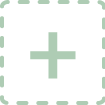Today I’m going to show you how to make an appliqué rag quilt. This project was inspired by the Patchwork Parcel box, and is sponsored by the subscription service Cratejoy.
My finished quilt will be a good size for a crib, or as a throw on the back of my loveseat. Of course, you can use these techniques to make a quilt in any size!
How to:
made with
cotton fabric
double-sided fusible webbing (Wonder Under)
scissors
1
Start by cutting your batting to the size you want your finished quilt to be. (Since my batting is currently sized for a table runner, I’m going to cut it in half and place the two pieces side by side.)
2
Layer your batting on the wrong side of the fabric that will be the front of your quilt. (In other words, the fabric is face-down, and you spread the batting on top of it.)
3
Adhere the batting to the fabric using a basting spray. Fold the batting back halfway, spray, then smooth onto the fabric. Repeat for the remaining portion of batting. Trim your fabric to the same size as your batting.
4
Now make a quilt sandwich by adhering the backing fabric on top, pattern side up. Trim fabric if needed.
5
I’m going to go ahead and bind the edges of this quilt now, as it will make it easier to evenly space my squares. I don’t have time to show you how to make the binding, but I do have another tutorial that demonstrates how to bind a quilt with mitered corners and an invisible join, so check it out if you need help.
6
Now we can make the squares for the quilt top. Draw a grid of squares on the smooth side of the Wonder-Under fusible webbing. Make the squares 1 inch smaller than you want your fabric squares to be. I’m drawing mine 2 inches wide, as my fabric squares will be 3 inches. Cut out the fusible squares.
7
Next let’s cut the fabric squares. Layer several printed fabrics together, then cut into squares, using a quilter’s ruler, rotary cutter, and mat. Again, the fabric squares should be 1 inch larger than the squares you cut from the Wonder-Under webbing; my fabric squares are 3 inches.
8
Lay out the squares in a grid on top of the quilt. Then, fuse a piece of webbing to the underside of each fabric square. The rough side should be against the fabric. Let cool for a moment, then peel off the paper backing. It should remove pretty easily, leaving a smooth film. If it doesn’t, iron for a few seconds longer.
9
Press the fabric squares to the top of the quilt. The Wonder-Under does a beautiful job of securing your squares, so you don’t have to fuss with pins.
10
Sew each side of each square to the top of the quilt, with about a 1/2 inch seam allowance. I’ve found it’s fastest to sew these in rows, rather than sewing one whole square at a time. I like to backstitch when starting and ending each side, for extra durability. Remember to start and stop sewing ½ an inch from the edge of the square.
11
Make snips ¼ inch apart, on every side of each square. This will help the fabric fray better. Machine wash and dry your quilt. (Rag quilts can be tough on washing machines, so you may wish to take it to the laundromat.)
12
The edges will continue to fray and get fluffier with subsequent washings. If you’re impatient and want to hurry the process along, you can rub the hook side of a piece of Velcro along the raw edge of the fabric to fray it more quickly.
This is a fun, non-traditional approach to quilting, and my Patchwork Parcel box made it super simple.
Made By Marzipan may have received product or payment for this post. Posts may contain affiliate links. Disclosed in accordance with the Federal Trade Commission's 16 CFR, Part 255.






 Finished?
Finished?